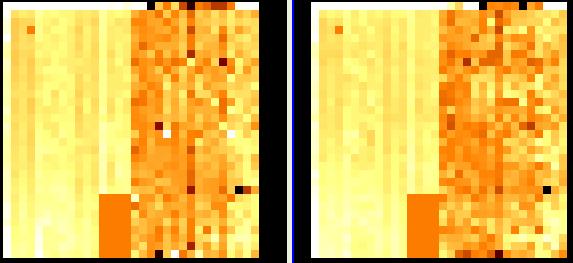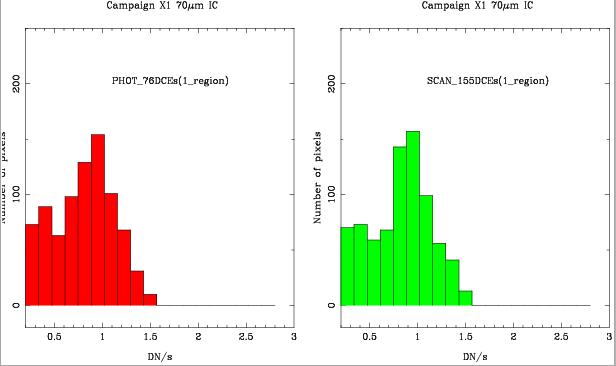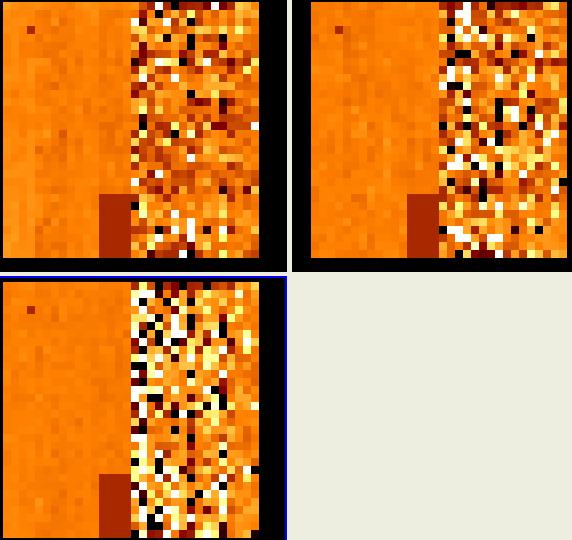
Figure1. Comparison of 70micron Illumination Corrections obtained in PHOTOMETRY (left) and SCAN modes (right). Both are displayed from z1=-2. to z2=2.
Principal:
Deputy:
Analyst:
AORKEYS:
Last Updated:
In PHOTOMETRY mode we obtained a 9 point dither map (1
cycle) at 70microns with 3 second DCEs of one region of
the sky (zodi_28b) chosen to avoid bright point sources.
The offsets between positions are 300 arcseconds. At each position of the dither pattern
there are 16 images (4 of which is an stim flash), so a total of 108
sky images were obtained to construct the
70micron Illumination Correction (IC).
In SCAN mode we have observed 1 degree (1 leg) in fast mode for one region of the sky (zodi14a), with a total of 166DCEs.
Since these tasks are repeated a number of times during IOC, we will observe
different regions of the sky each time. The tasks will check for possible
variations of quality of IC or saturation. This task will also be useful for
screening regions of the sky to obtain ICs in SIRTF routine operations.
The reduction was performed with the DAT programs. We used mips_sloper with
sensitive cosmic ray detection (-q option)
turning off the electronic non-linearity correction, mips_caler (using
the me_70_darka_CamX1_18nov2003.fits)
and mips_enhancer with the following options:
verbose = 0
scale = 1.
filename = ic70_scan
prefix = ic_scan70
nXTile = 1
nYTile = 1
dark = 0
flat = 0
illumination_correction = 1
NormalizeInput = 1
SigmaCut = 3.0
SigmaTolerance = 0.25
MaxIterations = 10
StackSTDEV = 0
OutlierMinPoints = 3
QuartileFactor = 10
OverlapTolerance = 0.5
diagonistics = 1
WriteGeometry = 0
WriteOutlier = 0
WriteTiles = 0
FluxMean = 0
FluxMedian = 1
OverWrite = 1
distortion = 0
UseBoostFrame = 1
reject = 1
NormalizeSideA = 1
Note that we rejected the first DCE after the stim flash (reject = 1 option, i.e, at
the end we only use 73DCEs in PHOT mode and 155DCEs in SCAN mode) and normalized
the input images (NormalizeInput = 1 option) using Side-A only (NormalizeSideA = 1).

Figure1.
Comparison of 70micron Illumination Corrections obtained in PHOTOMETRY (left) and SCAN modes (right).
Both are displayed from z1=-2. to z2=2.

Figure2.
Histograms of the 70micron Illumination Corrections observed in Campaign X1
obtained in PHOT and SCAN modes.

Figure3.
Examples of ratios of 70micron Illumination Corrections: up-left: phot to scan, up-rigth: phot to phot (half of the DCEs to the other half), bottom-left: scan to scan (half of the DCEs to the other half).
All images are shown with z1=-2 and z2=4.